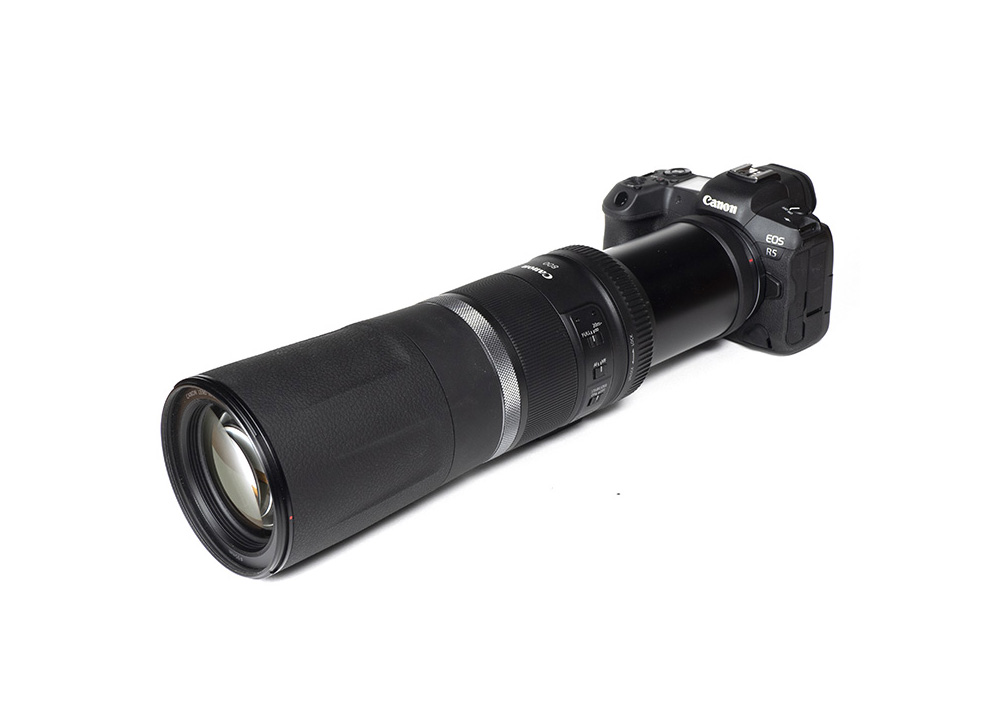Introduction
At the time Canon announced the Canon RF 600mm f/11 IS STM and RF 800mm f/11 IS STM, the photo community was a little confused. While (all-manual) slow, long tele tele prime lenses have been around for decades, these were mostly confined to more or less obscure third-party manufacturers. e.g. The oldies among you may remember the T-mount Samyang/Vivitar/Exakta 500mm f/8 from the 1970s and 80s, but with the emergence of 500/600mm zoom lenses, these vanished into history.
So why a modern 600/800mm f/11? There are a couple of reasons, of course. The most obvious one is costs. Canon R-mount is a closed system, and Canon lenses are expensive. The Canon RF 100-500mm f/4.5-7.1 USM L IS may be an obvious choice here … if you’ve got the money for it. Conversely, the Canon RF 800mm f/11 IS STM has a price tag of “just” $999 USD/EUR (and the more sane 600mm f/11 comes in at $799). Making such an extreme focal length accessible to the masses is commendable, to say the least. The other aspect probably relates to strategy. Micro-Four-Thirds have always been bragging about the fact that their long tele lenses are so small and affordable (and e.g. a Leica 100-400mm f/4-6.3 is a 200-800mm f/8-12.6 at equivalent settings), and providing another killing blow to MFT was certainly among the thoughts behind the design decision. So let’s see what the RF 800mm f/11 IS STM brings to the table now.
The Canon RF 800mm f/11 IS STM isn’t just a weirdo regarding its max aperture – the setup procedure is also unusual. If you switch on the camera, you will be greeted with the message to put the lens in working mode. And this requires turning a lock ring near the mount, pushing the outer lens tube forward, and finally locking it into the position again. Basically, it’s a zoom lens without being a zoom lens. However, other than being odd, there’s nothing wrong with this also because this extension/retractable mechanism also allows for a very compact transport size. The lens is very lightweight (for a long tele) at just 1.26kg, yet it also feels pretty sturdy. The lens barrels appear to be some kind of quality plastic. The front section is also nicely faux-leather textured. There is also a rather tiny dedicated tripod mount (non-rotating). Typical for most Canon RF lenses, there’s a dedicated configurable control ring for shutter speed, ISO or exposure compensation. The broad focus ring turns smoothly. A lens hood is OPTIONAL – an unfortunate cost-saving measure here.
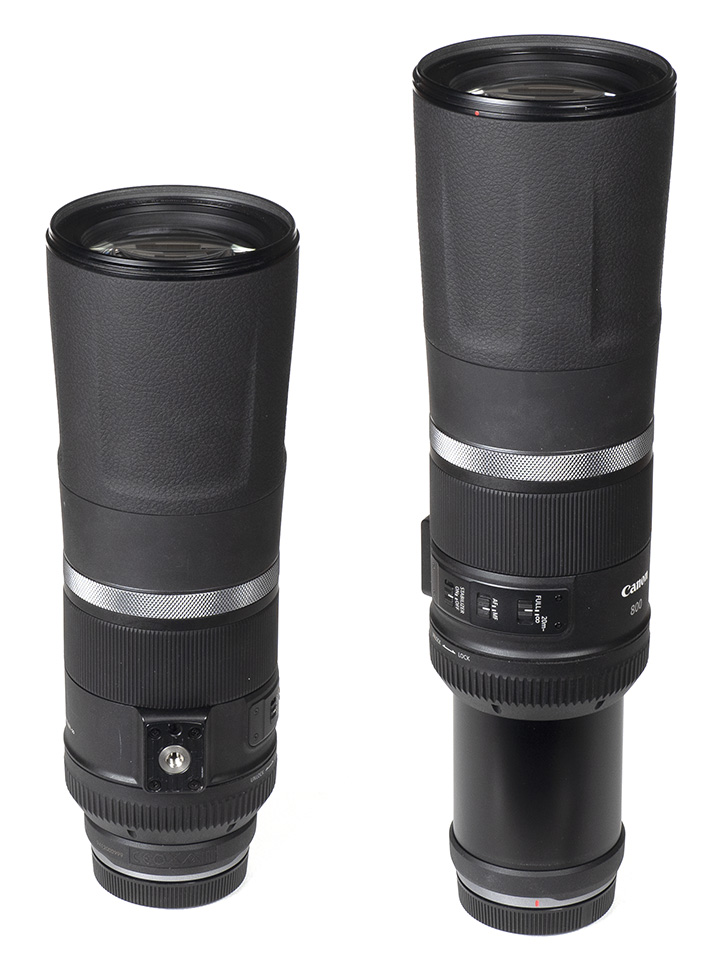
Canon opted for their STM-driven autofocus. It isn’t the fastest on the planet but still quite decent and, as usual, noiseless. In case you wonder – DSLRs were limited to a minimum of f/5.6 or max f/8 for autofocusing. Mirrorless cameras can go beyond this. Even so, the AF area is reduced to 40% horizontally and 60% vertically. If you think of using a teleconverter – which is possible – you have to be a little desperate due to diffraction effects at f/16 and f/22. The 800mm f/11 has a built-in image stabilizer which is good enough for 4 f-stops (the 600mm f/11 can give you 5 f-stops) which is rather modest at such a long focal length. Dual-IS with the camera’s IBIS is not provided.
| Specifications | |
|---|---|
| Optical construction | 11 elements in 8 groups including 1xDO element |
| Number of aperture blades | fixed) |
| min. focus distance | 6m (max. magnification ratio 1:7.1) |
| Dimensions | 101.6×281.8mm (extended: 352mm) |
| Weight | 1260g |
| Filter size | 95mm |
| Hood | barrel-shaped (bayonet mount, optional) |
| Other features | Control ring, focus distance switch, 4 f-stop image stabilizer, fixed tripod mount |
Distortion
The Canon RF 800mm f/11 IS STM is basically distortion-free in RAW images already, and the remaining traces are fully autocorrected.
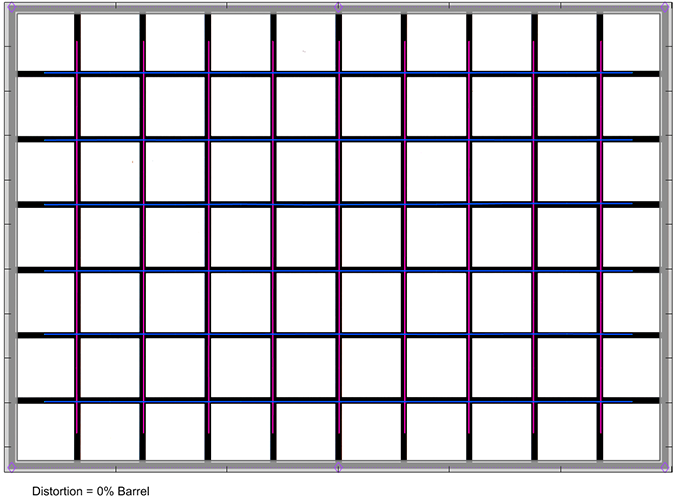
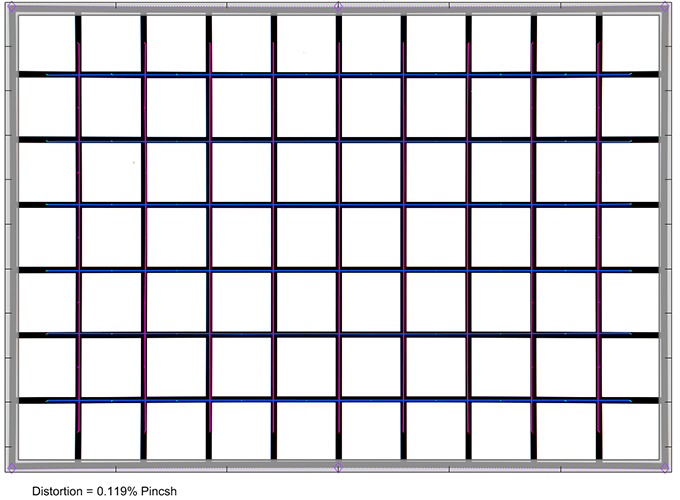
Vignetting
The native vignetting is a bit on the high side at 1.6EV (f-stops). However, auto-correction reduces this to ~0.6EV, which is usually not disturbing anymore.
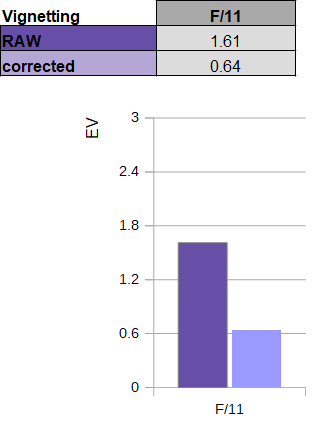
Diffraction and Megapixels
Before looking at the MTF charts, let’s take a little side step and look at the reality of things in terms of diffraction.
The illustration below shows the megapixel limit due to diffraction in relation to some apertures (on full-format cameras). You may spot that f/11 translates to a maximum resolution of about ~27 megapixels.
If you own an EOS R5 (45 megapixels), this may sound like a dramatic limitation but keep in mind that we have Bayer sensors, and the effective resolution after demosaicing is quite a bit less than the nominal one.
There’s some debate about how much this is, but think of a 30% loss as guidance. So for a 45mp sensor, you’ll end up with ~34mp effectively.
Even so, at f/11, you don’t exploit the full potential of the sensor anymore.
Also, note that the 27mp limit for f/11 is slightly optimistic – the limit is dependent on the wavelength of light, and 27mp applies to the higher frequencies of the visual spectrum.
The chart also illustrates that using a teleconverter would reduce the resolution to dismal levels (f/16 w/1.4x and f/22 w/2x)
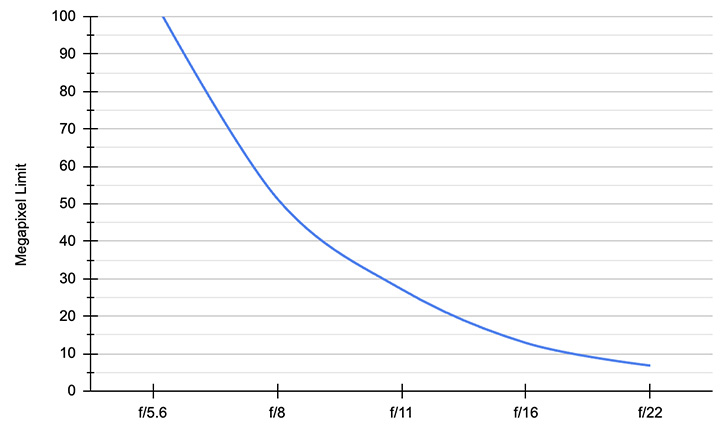
MTF (resolution) at 45 megapixels
The resolution of the “naked” Canon RF 800mm f/11 IS STM is very good in the broader image center and still good to very good in the outer image field.
The centering quality of the tested sample was very good. The field curvature is low.
Please note that the MTF results are not directly comparable across the different systems!
Below is a simplified summary of the formal findings. The chart shows line widths per picture height (LW/PH) which can be taken as a measure of sharpness. If you want to know more about the MTF50 figures, you may check out the corresponding Imatest Explanations
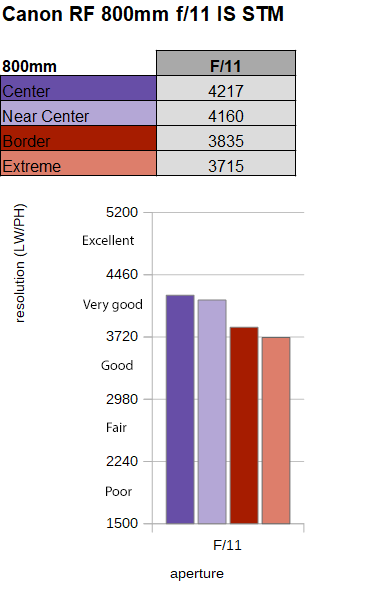
MTF (resolution) at 30 megapixels
The resolution at 45mp may be interesting, but most users still own consumer cameras in the 20-30mp class, so let’s do the reality check at “just” 30mp.
Unsurprisingly, the subjective quality on pixel level increases slightly, with the center reaching an excellent level (just) and very good borders/corners.
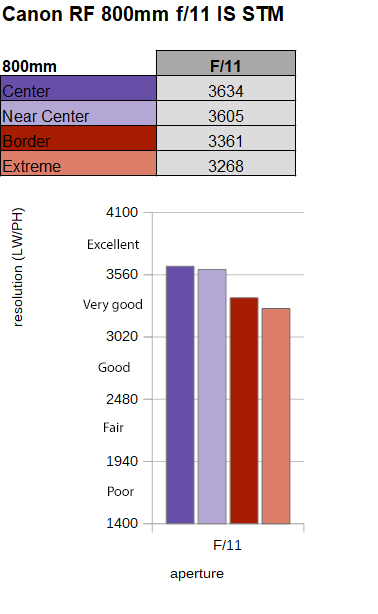
Chromatic Aberrations (CAs)
Lateral CAs have an average width of around 1px at the image borders. This is quite well controlled already – and gone with auto-correction.

Bokeh
Why even look at the bokeh given an aperture of f/11, you might ask? Well, at a distance of 25m, the depth of field is merely half a meter. And if you look at our sample image section, you can verify that you can actually isolate an object from its surroundings unless it’s really far away.
The Canon RF 800mm f/11 IS STM uses a DO element in its design. Traditionally, this wasn’t an indicator of a good bokeh, but Canon improved this over time. Out-of-focus highlights are quite nicely rendered, with just a hint of outlining at the edges.

When looking across the image field, the highlights do deteriorate quite early toward “cat eyes”, though.
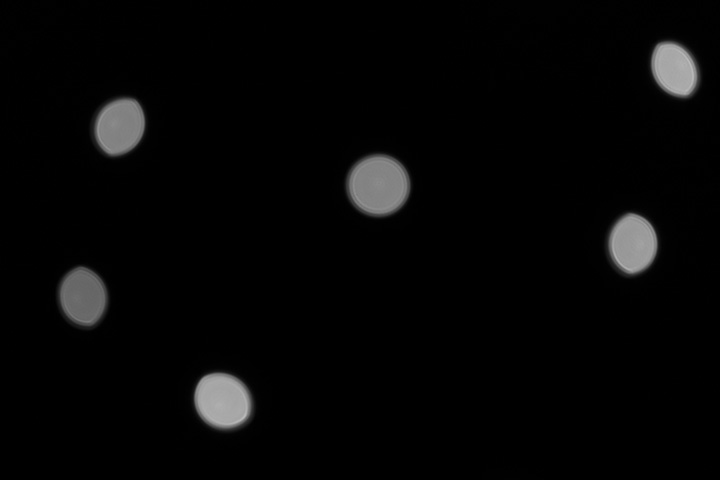
As far as the general blur in the focus transition zone is concerned, it’s very smooth in the image background – shown to the left below. The foreground is just a tad more busy, but still pretty good.

Sample Images
Competition
As of the time of this article, Canon R is still a closed system, so the only real competitor for the RF 800mm f/11 IS STM (to the left below) is its in-house mate, the RF 600mm f/11 IS STM (2nd left). We haven’t tested this one so far, but it’s likely to be in the same performance class. Because it’s “just” a 600mm lens, it is more compact, more lightweight and also more affordable. The image stabilizer is also 1 f-stop more effective, and combined with the shorter focal length, this can be a substantial advantage in keeping high ISO settings somewhat at bay.
It may be interesting to look at the other side of the pond, nonetheless. On the Sony side of things, there’s the 200-600mm f/5.6-6.3 G OSS (2nd to the right) – a killer offer regarding its combination of reach, speed and affordability. Still, while the Sony lens can produce impressive images, the Canon lens has a slight edge. This is, of course, not overly surprising in a comparison between a zoom and a prime lens.
As mentioned above, Canon is surely also trying to compete with smaller format systems that are aggressively promoting their long tele capabilities. e.g. Fujifilm just released their XF 150-600mm f/5.6-8 R LM OIS (center below). Effectively, it’s a ca. “225-900mm f/8-11” at comparable setups – with similar limitations in terms of diffraction. It’s pretty good indeed and more flexible but, just like the Sony lens, it is also more expensive.
Micro-four-thirds has a couple of lenses reaching “800mm”. The Leica 100-400mm f/4.5-6.3 OIS (shown to the right) is one of these options. Technically, it is slower at 400mm f/6.3 (= ~800mm f/12.3) but still a bit more compact. Once again, we’d rate the Canon lens as somewhat sharper in comparison.
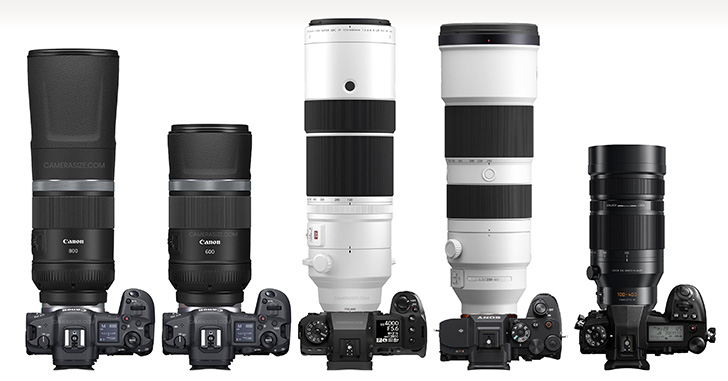
Visual comparison courtesy of camerasize.com.
We didn't expect too much from the Canon RF 800mm f/11 IS STM. However, after having used it in real life, it has its merits - with a couple of caveats. Despite the slow aperture, it can be surprisingly sharp. The CAs are low, and image distortions are absent. There's some vignetting in RAW files, but it's well auto-corrected. Despite common perception related to the max aperture of f/11, the quality of the bokeh is actually quite good. It's also a very well-made lens. The used materials are of high quality despite targeting consumers rather than professionals. Canon did, however, omit weather-sealing, which is hard to understand because this is an outdoor-only lens, really. The retractable design may seem to be odd at first, but you can get used to this in no time. Unlike its (distant) professional cousin, it is actually a quite portable lens that you can carry for long distances without breaking your back. The AF speed is sufficiently fast unless you want to use it for very fast action photography. Keep in mind that the covered AF field of the camera is somewhat reduced, though.
The big elephant in the room is, of course, the max aperture of f/11, and most will use this lens in hand-held mode. More often than not, you will shoot at very high ISO settings of > ISO 2000 or (much) higher - also because the image stabilizer isn't all that efficient at just 4 f-stops. Traditionally, ISOs this high were like entering a no-go zone, and it still is if you prefer JPEGs straight out of the camera. When using advanced RAW converters such as DxO RAW/PhotoLab or Topaz Labs DeNoise AI, the results can be impressive - although limitations regarding dynamic range still apply. Even with all the support from new AI tools, shooting in low light is a challenge.
While the Canon RF 800mm f/11 IS STM can deliver nice, if not great, results, we still wished that it was one f-stop faster. This would have (roughly) doubled the price tag and also the size/weight, but the potential gain in practicality would have been worth it. That being said, the lens is primarily targeting amateurs, and most of us have a tight budget for just-of-fun equipment, and it will surely find friends among wildlife photographers.-
Optical Quality
-
Build Quality
-
Price / Performance


